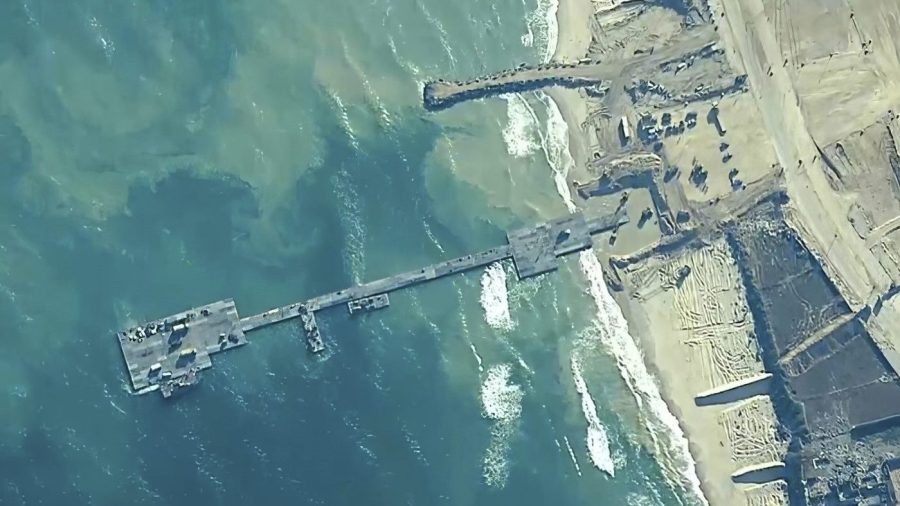
The Department of Defense announced in July that it was permanently removing the temporary pier that it had constructed three months earlier to deliver humanitarian aid to Gaza. The pier was part of a modular structure that would also incorporate a floating platform to receive supplies transported by four Army logistics ships deployed from Cyprus.
President Biden had announced the plan in his State of the Union address, promising that “this temporary pier would enable a massive increase in the amount of humanitarian assistance getting into Gaza.”
The plan was for the pier to operate for three months, during which the administration estimated that the effort would result in enough aid to feed 1.5 million people. But the pier and its associated system functioned for only 20 days. The Pentagon had to interrupt operations three times before deciding to terminate the effort. The operation ultimately supported only 450,000 people and delivered 8,100 metric tons of aid.
The Defense Department claimed that, despite its premature termination of the effort, it had nevertheless made a major contribution toward feeding and otherwise aiding the Palestinians of Gaza. In fact, nearly three times as much aid — some 22,400 metric tons — had entered Gaza through the Erez and Kerem Shalom overland crossings during the same three-month period when the pier was operating.
According to Israeli sources, it was Prime Minister Benjamin Netanyahu who proposed the project to Biden. His idea was not new; then-Foreign Minister Avigdor Lieberman had first proposed a sea-based aid plan for Gaza in 2010.
The Agency for International Development, whose Bureau of Humanitarian Assistance was already providing aid via the land routes to Gaza, pushed back against the pier plan when the administration first began considering it. Agency officials pointed out that the land crossings were more efficient, which they ultimately proved to be. Moreover, the agency argued that there were both logistical and technical challenges for the pier, which had never before operated in a conflict environment.
Aid officials also worried about the impact of inclement weather in the eastern Mediterranean. The floating platform is meant to function in low sea states, when waves are short or moderately high. Summer winds in the Mediterranean tend to be strong, creating higher wave heights. Nevertheless, once Biden had made his announcement, the Pentagon and the Agency for International Development pressed ahead with the plan.
On June 5, a week after the operation had been halted for the first time due to high winds that caused the floating pier to split apart, Defense Department Deputy Press Secretary Sabrina Singh announced a reduction from the originally estimated cost of $320 million for the three-month effort to about $220 million. She asserted that this figure included part of the cost of the repairs. It is not clear, however, just how much of the $22 to $28 million cost to repair the pier was incorporated in her estimate. In any event, it surely did not include the cost of dismantling the pier prematurely.
It is not clear whether the Defense Department initially proposed the pier, but it did fund the effort and supplied 1,000 troops and four ships to transport the aid to the floating dock. It constructed the floating pier that would be attached to a temporary causeway. Nevertheless, once the project proved to be what can only be called a misguided failure, the department did not take responsibility for urging that Washington undertake the project in the first place.
Perhaps the idea originated with the White House itself rather than the Pentagon. In any event, it was Biden who simply stated, “I’ve been disappointed that some of the things that I’ve put forward have not succeeded as well, like the port we attached from Cyprus — I was hopeful that would be more successful.” He did not, of course, mention the complete waste of a quarter-billion dollars, as well as of the efforts of the 1,000 American troops who conducted the operation.
In retrospect, it is clear that someone at the administration’s most senior levels should have personally transmitted to Biden the compelling reservations about the project from the Agency for International Development. No one seems to have done so.
There is an understandable reluctance among senior military officials in particular, but also among top civilians, to confront the commander in chief once he appears to be determined to follow a course of action. But as former National Security Advisor H.R. McMaster convincingly demonstrated in his 1997 study of senior political leadership’s failure to advise President Lyndon B. Johnson of the negative consequences of his Vietnam War policy, failure to question a proposed presidential policy is, as the title of his volume indicates, nothing less than a “dereliction of duty.”
All too often, senior officials treat the president as an all-knowing emperor, and fear for their jobs should they have the temerity to challenge him. The lesson of the Gaza pier is that their responsibility is to their country, and indeed to their consciences. By withholding the best advice they can give, they do their commander-in-chief no favors.
Dov S. Zakheim is a senior adviser at the Center for Strategic and International Studies and vice chairman of the board for the Foreign Policy Research Institute. He was undersecretary of Defense (comptroller) and chief financial officer for the Department of Defense from 2001 to 2004 and a deputy undersecretary of Defense from 1985 to 1987.

